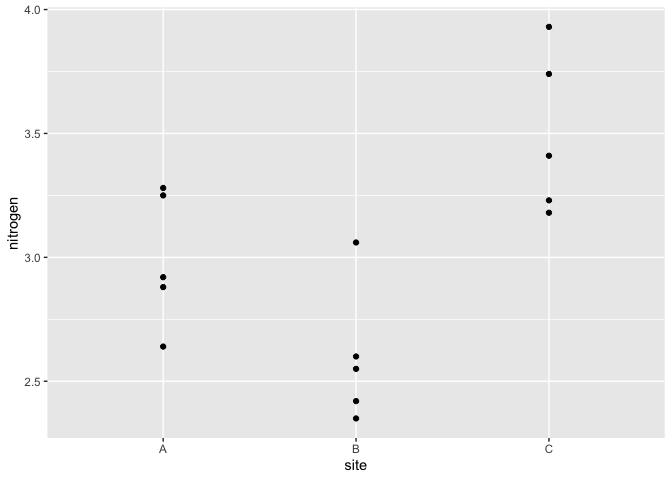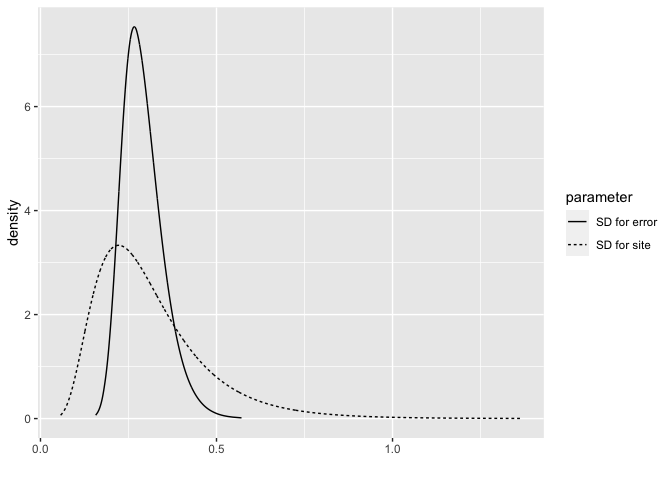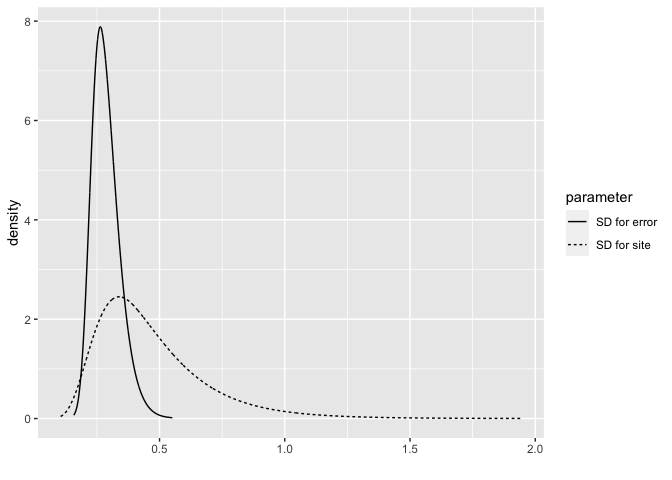brinla
Define your own prior with INLA
Julian Faraway 21 September 2020
Initialization
See the introduction for an overview. Load the libraries:
library(INLA)
library(brinla)
library(ggplot2)
We illustrate the method using the following data:
data(reeds, package="brinla")
ggplot(reeds,aes(site,nitrogen))+geom_point()

We will build a model of the form:
nitrogen = intercept + site + error
where intercept is a fixed effect modeled with a normal prior with a
zero mean and large variance. The site is a random effect and error
is the error term. These have distributions which are normal with mean
zero and some variance. These variances are treated as hyperparameters
with priors we shall specify.
Analysis with default prior
By default, INLA places a gamma prior on the precisions (inverse of the variance). We fit this model and examine the posteriors in terms of the SDs (which are easier to understand than precisions)
formula <- nitrogen ~ 1 + f(site, model="iid")
imod <- inla(formula,family="gaussian", data = reeds)
bri.hyperpar.summary(imod)
mean sd q0.025 q0.5 q0.975 mode
SD for the Gaussian observations 0.29079 0.05833 0.19817 0.28283 0.42608 0.26647
SD for site 0.31313 0.15740 0.10893 0.27910 0.71369 0.22176
We can also plot the posteriors of these two SDs.
bri.hyperpar.plot(imod)

PC prior
INLA has other choices for the priors. Here is an example using the penalized complexity prior. We use the SD of the response to help us set the scale of this prior (although it is better if you set this with knowledge of the problem behind the data)
sdres <- sd(reeds$nitrogen)
pcprior <- list(prec = list(prior="pc.prec", param = c(3*sdres,0.01)))
formula <- nitrogen ~ f(site, model="iid", hyper = pcprior)
pmod <- inla(formula, family="gaussian", data=reeds)
bri.hyperpar.summary(pmod)
mean sd q0.025 q0.5 q0.975 mode
SD for the Gaussian observations 0.28651 0.055529 0.19794 0.27906 0.41494 0.26358
SD for site 0.46599 0.219838 0.18247 0.41706 1.02813 0.33867
Plot the posterior densities.
bri.hyperpar.plot(pmod)

Half Cauchy prior
It is possible to set our own prior for the SD of the site effect. The
use of the half(ie. positive part of) Cauchy is a commonly used choice
which is not directly programmed in INLA. The density for the SD
((\sigma)) with scaling (\lambda) is: [
p(\sigma | \lambda) = \frac{2}{\pi\lambda(1+(\sigma/\lambda)^2)}, \quad\quad \sigma \ge 0.
]
We calculate scaling equivalent to the PC prior scaling for future use:
(lambda = 3*sdres/tan(pi*0.99/2))
[1] 0.022066
INLA works with the precision and the calculation requires the log density of the precision, (\tau), which is [ \log p(\tau | \lambda) = -\frac{3}{2}\log\tau - \log (\pi\lambda) - \log (1+1/(\tau\lambda^2)) ]
We then define the prior as:
halfcauchy = "expression:
lambda = 0.022;
precision = exp(log_precision);
logdens = -1.5*log_precision-log(pi*lambda)-log(1+1/(precision*lambda^2));
log_jacobian = log_precision;
return(logdens+log_jacobian);"
And use this prior with
hcprior = list(prec = list(prior = halfcauchy))
formula <- nitrogen ~ f(site, model="iid", hyper = hcprior)
hmod <- inla(formula, family="gaussian", data=reeds)
bri.hyperpar.summary(hmod)
mean sd q0.025 q0.5 q0.975 mode
SD for the Gaussian observations 0.28763 0.056198 0.19809 0.28006 0.41769 0.26436
SD for site 0.42336 0.231600 0.14712 0.36565 1.03013 0.28080
Plot the posterior distributions:
bri.hyperpar.plot(hmod)

The result is quite similar to the penalized complexity prior.